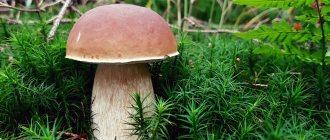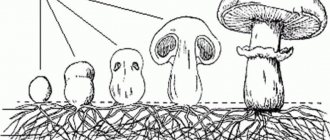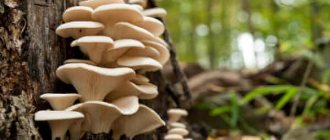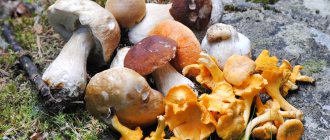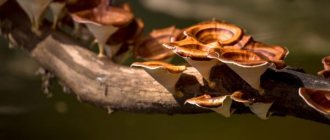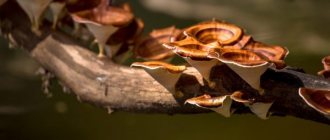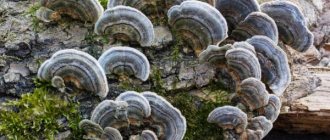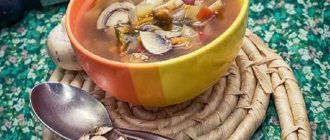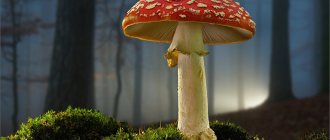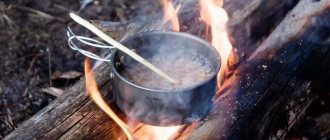Sometimes small rust-colored stripes or spots can be seen on wheat stalks, apple, pea or juniper leaves. In ancient times, people believed that the cause of the appearance of rusty formations could be high humidity or scorching rays of the sun. However, they were mistaken and did not even imagine that parasites—rust fungi—affect agricultural plants in this way.
Today, the rust order has been quite accurately described by researchers: this gives hope to amateur and professional gardeners not only to successfully apply measures to combat the parasite, but also to promptly prevent infection of healthy plants, which will help protect the future harvest.
Where my food is, there I am
In recent years, rust fungus has spread quite widely. This is due to changes in agriculture: more and more areas in different parts of the planet are planted with those cereals on which it can settle. Co-evolution closely links the rust fungus and cereal crops. As observations have shown, the greatest diversity of forms of the pest is characteristic of those areas where there are many plants on which the fungus can settle. Plants actively cultivated by humans are gradually spreading throughout the planet, and along with them, the rust fungus is becoming increasingly widespread.
Biology has been studying this specific form of life for quite some time. In particular, it was possible to reveal that the spore-bearing stage of development in rust fungi presupposes the presence of five types of spores: basidio-, telite-uredo-, aecidiospores, and spermogonia. The latter are formed as pycnidae. But telytospores exist consisting of only one cell or two, and can also include many cells. Such spores are covered with a thicker shell than others.
Ecology DIRECTORY
Fungi belonging to this order cause diseases of many plants. Symptoms of plant damage are spots or stripes that are usually rusty-brown in color (Table 54). Hence the name of the entire group of fungi of this order - rust mushrooms. Rust of cereals and other agricultural plants has been known since ancient times. A number of writers who lived before our era indicate the widespread prevalence of bread rust in Egypt, Greece, Rome and other ancient states. There are also references to the appearance of rust during the times of appanage Rus'. The devastating outbreaks (mass outbreaks) of this disease on grains from ancient times to the present day have attracted people's attention to elucidating the causes of plant death due to rust. And although the ancient Christians annually performed prayer rituals in honor of the god Robigus, this did not stop them from making observations in nature about the nature of the disease on bread. The ancient Romans wondered whether rust could occur as a result of cooling plants or excessive heating of dew drops on the leaves by the sun's rays. It has also been observed that plants in lowlands are more susceptible to rust and that different varieties of plants suffer from this disease to varying degrees.[...]
The fungus attacks leaves and shoots. Heaps of orange-yellow spores appear on them, subsequently growing into large spots. Infected plants develop poorly and weaken. The fungus overwinters on infected fallen leaves and affected plant branches.[...]
Rust of cereals is caused by fungi from the class Basidiomycetes (Basidiomycetes), order Rust myciumidae). [...]
Fungi-phytoparasites of grass biocenoses are diverse. Among them, rust, powdery mildew, and smut are widespread. Rust fungi parasitize mainly on the vegetative organs of cereals, sedges, legumes, and forbs, while smut fungi parasitize the vegetative and generative organs of plants. Fungi that parasitize roots are widespread. They cause root rot in meadow and creeping clovers, reduce their productivity, and cause the death of seedlings. Saprotrophic fungi are involved in the destruction and mineralization of dead organic matter of plant and animal origin. The bulk of saprophytic fungi is concentrated in the turf. Most soil fungi live and reproduce in well-aerated, sufficiently moist neutral or slightly acidic soils. The group of saprotrophic fungi involved in the decomposition and mineralization of feces are coprotrophs. The number of coprotrophic fungi in pasture BGCs is usually higher than in grasslands.[...]
Caused by rust fungi. In the summer, rusty red, brownish, or orange pads appear on the leaves. In winter, fungal spores form black piles. Carnations, palm trees, citrus fruits, camellias, pelargonium, bulbous and other plants are affected.[...]
All stages can be observed on one plant (sunflower rust), and in some species, spermogonia and aecidia are formed on an additional intermediate host (cereal rust, pea rust, etc.).[...]
Rust fungi are obligate parasites. They have a complex development cycle. For some, the entire development cycle takes place on one plant, while for others, on two plants.[...]
During the growing season, the disease manifests itself in different forms, which is explained by the formation of various stages of sporulation of a monoecious pathogen - the rust fungus Phragmidium rutji-idaei Karst, from the order Uredinales. Initially, individual yellowish-orange, well-demarcated aecia appear on the upper side of the leaves. Sometimes they form on leaf petioles, on large veins on the underside of leaves and on young green shoots. Later, small rusty-brown, vague uredinia with urediiospores appear on the underside of the leaves. They are not found on other plant organs. In mid-summer, teliospores also form on the underside of the leaves in the form of a dark, easily erased coating. [...]
Rust fungi on cereals, as on other crops, are obligate, highly specialized parasites. OPP have adapted to infect certain species and varieties of cultivated plants, causing them significant harm.[...]
Spermogonia appear as pycnidia. In summer, uredospores (summer spores) are formed; they are single-celled, on a thin stalk and in mass form yellowish or brownish pads (pustules). During the summer, uredospores form several generations (generations). By autumn, most rust fungi develop dark pads of telytospores (winter spores). According to their structure, telatospores can be unicellular, bicellular or multicellular, their shells are thickened.[...]
Types of rust fungi that have all the indicated types of sporulation in their development are classified as forms with a full development cycle. Many rust fungi lack some types of sporulation. They are called incomplete forms.[...]
During the tens and twenties of this century, one of the rust fungi removed the chestnut from North American forests.[...]
Fighting rust fungus due to rapid damage is useless. Seeds from surviving varieties should be collected separately, if necessary, and the seeds should be treated before sowing. Places for growing snapdragons affected by rust should be limed and not occupied by this type of flyweed in the coming years.[...]
Blister rust of Weymouth pine and Siberian cedar is caused by the rust fungus Cronarthium ribicola Diet. The disease is characterized by the formation of thickenings and cancerous ulcers on trunks and branches at sites of infection. The fungus has two hosts and is characterized by a complete development cycle. Its aecidial stage in the form of large, up to 1 cm in diameter, bubble-like swellings of sulfur-yellow color develops on the trunks and branches of Weymouth and cedar pines. Rust mycelium is perennial. Its growth causes thickening of the affected areas, and when the trunks or branches become ringed, the parts located above the lesion site die off. [...]
Other types of fungi can induce true or apparent resistance to viral infection in the plant. Thus, on tobacco plants of the Xanthi variety, the stem of which was injected with a suspension of spores of the fungus Regopo-spora tabacina Adam., less local necrosis was formed compared to the control if the plants were inoculated with TMV 3 weeks after infection with fungal spores; the resulting necrosis was smaller than on control plants [1141]. The fungus Thielaviopsis basicola causes local necrosis in tobacco plants. Hecht and Batemai [753] found that when the lower leaves of tobacco plants are infected with this fungus, the upper leaves acquire resistance to tobacco necrosis virus and TMV (resistance was judged by the size of local necrosis caused by the viruses). Perhaps the size of visible lesions and their number cannot be considered a sufficient criterion for assessing changes in plant resistance to viral infection, since in the above work, when bean plants were infected with rust fungi, the reproduction of the virus sharply increased, while the formation of necrotic lesions was completely suppressed. [... ]
Goblet rust of currants and gooseberries - Puccinia ribesii - caricis Kleb. Distributed mainly in the western and northwestern zones, Siberia, in places where there are many sedges growing nearby, which serve as the main host of the rust fungus. On currants and gooseberries, the spring aecidial stage develops in the form of yellowish-orange “pads”, “cups” (aecidia with aecidiospores) on the underside of the leaf, on flowers or on young berries.[...]
When rust develops on a plant, local infection usually occurs, that is, the lesion is observed in a small area where one fungal spore has landed. In a small number of species, the mycelium can penetrate the entire plant and cause so-called diffuse damage to the entire plant. Rust fungi are also characterized by massive dispersion of spores. Settled on plants, rust spores, carried by the wind for many kilometers, cause many local foci of infection on a plant of the same species. [...]
There are known types of rust fungi that parasitize the sporophyte of a number of Lygodium species, with the second host being fir.[...]
Brown (leaf) rust of wheat (Ricecinia recóndita f. sp. tritici) and rye (R. recóndita f. sp. secalis) are rust fungi of different hosts. They infect the leaves of seedlings and adult plants of wheat and rye. However, the massive development of the disease is most often observed in the summer, when brown, randomly located pustules that break through the epidermis develop on the leaf blades and leaf sheaths. They contain round, less often oval-rounded, uredoepores covered with spines. Like all types of bread rusts, uredo spores produce several generations over the summer and can cause massive damage to wheat and rye.[...]
If rust fungi do not have aecidiospores, uredospores or other spores, their development cycle is incomplete. These fungi cause rust of needles and leaves of many tree species and shrubs.[...]
The distribution of rust fungi is associated with the distribution of plants on which they develop. The close connection between rust and plants is due to their joint evolution. P. M. Zhukovsky, developing the views of N. I. Vavilov, created the theory of conjugate evolution of the parasite and the host plant. According to this theory, in the centers of plant origin, along with a diversity of plant forms, there is a diversity of parasite forms. The spread of plants around the globe leads to the spread of races of the parasite.[...]
The history of coffee rust suggests that rust fungi, when developed en masse, can cause enormous economic damage to agricultural production. Their spread even to new continents is carried out with amazing ease.[...]
These are higher mushrooms. The sporulation organs are basidia, in the form of simple or club-shaped outgrowths, most bearing four basidiospores. In some basidiomycetes, basidia develop openly, without fruiting bodies (rust fungi), while in others they arise in fruiting bodies (tinder fungi). Based on the structure of the basidia, this class of fungi is divided into two subclasses—phragmobasidiomycetes with articulated basidia and holobasidiomycetes with unicellular basidia.[...]
A germinating spore of a rust fungus produces a so-called germ tube, which most often penetrates the tissues of the host plant through stomata. The mycelium of the fungus grows and spreads inside the plant tissues, sending haustoria into the cells, with the help of which the fungus feeds. The hyphae of rust fungi spread throughout the intercellular spaces of the host plant. Contact between the cytoplasm of the host and the parasite occurs at the tips of the haustoria. It was recently shown that there is no membrane at the end of the haustorium adjacent to the cytoplasm of the host plant. In this place there is only a cytoplasmic membrane through which the host’s nutrients pass into the mycelium of the parasite.[...]
Diseases caused by rust fungi (rust of pine shoots, rust of pine needles, spruce, larch), damping off and other diseases (mold, suffocation) of coniferous seedlings. Distribution and comparative harmfulness of certain types of diseases. Diagnostic signs of diseases, biological characteristics of pathogens. [...]
Developing on pustules of rust fungi, dar hatch filamentous forms a white, usually inconspicuous mycelium, and on it there are small spherical pycnidia, 50-200 microns in diameter, which look like small black balls under a magnifying glass (Fig. 268). In one pustule they form from 1-3 to several dozen. Each pycnida produces about 6000-8000 spores, colorless, fusiform, with one septum and filamentous appendages at the ends. The spores are glued together by mucus and emerge from the pycnida in the form of a long whitish or grayish thread. Once on plants, spores germinate in droplets of water. If the plant is not infected with rust, the sprouted spores die. If they germinate in a pustule of a rust fungus or near its uredospores, the mycelium of the parasite develops, surrounding the hyphae and spores of the host and feeding on their contents. Sometimes it penetrates into the host cells. When hyperparasite spores germinate in a mixture with uredo-spores of rust fungi, a tropical reaction is observed in their germ tubes - they grow towards the germinating uredospores of the host. [...]
From the buckthorn laxative, the rust fungus is transmitted to oats.[...]
Basidiomycetes are higher fungi with multicellular mycelium. These include about 30 thousand species (both microscopic fungi and fungi with large fruiting bodies). Among these fungi there are plant parasites (for example, smut and rust fungi, which are widespread and very dangerous for agricultural plants), and numerous soil saprophytes - well-known cap mushrooms (for example, champignons, dung beetles). Basidiomycetes also include mycorrhiza-forming cap mushrooms, which successfully develop only in close contact with the roots of woody plants (for example, boletus, boletus, boletus and many other forest mushrooms).[...]
The secretions of spermogonia stimulate the germination of parasite spores, and it develops well on them. This fungus infects only open spermogonia and aecidia of the rust fungus. In some countries, this hyperparasite, when widespread, suppresses the development of the causative agent of blister rust. In nature, this fungus is probably a natural regulator of the host population. Thus, in North America, after the use of certain antibiotics to combat pine blister rust, the development of the hyperparasite was suppressed, and this caused an unexpected outbreak of blister rust development.[...]
Specialized forms of rust fungi, in turn, are divided into physiological races that differ from each other in their ability to infect certain varieties of the same host plant species. Thus, over 300 physiological races have been identified so far in the causative agent of wheat stem rust. In all regions of the world, constant records are kept of the presence of certain races in crops of wheat and other crops affected by rust. This work is needed in order to promptly develop varieties that are resistant to certain races of pathogens. Rust fungi are highly variable. In nature, as a result of the sexual process or mutations, constant changes occur in the racial composition of parasites in certain areas. Therefore, registration of races that attack varieties previously resistant to them is carried out in all countries of the world. In our country, wheat varieties bred by Academician P. P. Lukyanenko have become widespread - Aurora, Kavkaz, Bezostaya 1, which are characterized by relative resistance to many races of rust fungi.[...]
There are also specific types of rust fungi that attack only cereal grasses. Thus, yellow rust (pathogen Puccinia dactylidina Bubak) and leaf rust (pathogen Uromyces dactylidis Otth.) are found on hedgehog grass, crown rust (pathogen Puccinia festucae Plowr.) is found on fescue, and common rust (pathogen Uromyces poae Rabh.) is found on bluegrass. , on rump - brown rust (pathogen Puccinia alternans Arthur.), etc. [...]
The causative agents of the disease are rust fungi Cronartium flaccidum Wint and Peridermium pini Lev. et Kleb, parasitizing pine in the aecial stage. It is believed that P. pini infects branches, and then the mycelium spreads into the trunk, developing mainly in the intercellular passages of the oak, from where it penetrates along the medullary rays into the wood cells and infects the resin passages. [...]
The massive disease of Weymouth pine with rust fungus (Repland silitoly) in most cases is explained by the history of the introduction of this species into the cultures of different countries and is by no means a mandatory property of this pine when carrying out proper preventive measures.[...]
A change of hosts is also observed in parasitic fungi. Thus, for rust fungi that attack cereals, barberry, washi leaf and other plants serve as intermediate hosts. Knowledge of life cycle parasites allows you to take preventive measures to reduce infection of host organisms. [...]
Intensive development of Darluka filamentous on rust fungi occurs at high relative air humidity and temperatures in the range of 12-26 °C. Therefore, this species can develop in almost all areas of the globe where rust occurs, from the tropics to the northern limits of its range. At high air humidity, the fungus forms abundant aerial mycelium, and at low humidity its mycelium is invisible; it often goes inside the plant tissue along with the host mycelium.[...]
The genus Puccinia is the largest in the order of rust fungi: it contains about 1800 species. They can be single-host or multi-host, with a full development cycle or reduced (incomplete forms). They parasitize plants of many families, mainly grasses, sedges, lilies, umbelliferae, and Asteraceae.[...]
Melekhov I. S., On the damage to spruce forests of the northern taiga by the rust fungus C11guzotukha 1esC O. V. “Proceedings of the Arkhangelsk Forestry Engineering Institute”, vol. VIII.[...]
Epidemic diseases of young trees caused by rust fungi, for example Chrysomyxa ledi D. B. on spruce, blister rust (Cronartium flaccidium Wint.) on pine, as well as the fungus Melampsora pinitorqua A. Braun., which causes the disease “pine Vertun" in areas where pine and aspen grow together. According to our data, spruce is more intensively affected by the rust fungus Chrysomyxa ledi D.V. (in the aecidial stage) in the most illuminated, open places. Undergrowth and self-seeding under the forest canopy are slightly damaged or not damaged at all by this fungus. In clearing areas, the amount of infected undergrowth during epidemic years ranges from 70% (undergrowth up to 0.5 m in height) to 100% (over 5 m in height). [...]
Weeds sometimes serve as intermediate hosts for pathogens of fungal diseases and thus contribute to their spread. The most striking example is the defeat of wheat by the rust fungus Puccinia graminis, the intermediate host of which is barberry (Berberis vulgaris).[...]
Nursery environment. It is recommended to establish forest nurseries in clearings or large clearings that are surrounded by sparse trees. They should not contain old aspen and pine trees, which are the intermediate host of rust fungus and “hypot-te”. It is not recommended to establish nurseries in clearings enclosed by the walls of dense plantings.[...]
Endotrophic and ectotrophic P. Endotrophic P. live inside the tissues of the host organism (flat and roundworms in the intestines of vertebrates, nematode roundworms in the stems of cereals), and ectotrophic P. “graze” on the surface of the host organism (fleas, lice, rust mushrooms and much more). A special case of ectotrophic parasitism is the lifestyle of dwarf male deep-sea anglerfish (see Parasite-Host Relationships). There are superparasites from the first to the fourth order (they can be represented in the form of a nesting doll), at the top level they are bacteria or viruses.[...]
Many barberries are known as ornamental plants. They were cultivated in Europe back in the 14th–15th centuries. Many types of barberry decorate gardens and parks. Due to the fact that on the leaves of many species of barberry and mahonia, spring, or ocidial, fruiting of the rust fungus (Puccinia graminis) is formed, which affects grain crops. cereals, planting of these plants is limited.[...]
Distributed throughout almost all forests of the Soviet Union, mainly in damp and damp soils - along river banks, in meadows, but is also found on dry soils, under the forest canopy. On the edges and clearings it reaches 15 m in height, 30-40 cm in thickness, and is more often found in the form of a shrub. It is quite demanding on the soil; it does not tolerate dry soil and air well. It is undesirable in spruce forests because it is an intermediate host of the rust fungus Pucciniastrum padi, which attacks spruce cones. Bird cherry twigs are used for hoops, coarse weaving, and cords. The fruits are consumed as food.[...]
The settlement of these plants in the northern regions of the taiga of the European part of the USSR can also occur in hilly locations with relatively dry and fresh soils, for example, in lingonberries. This circumstance, as shown by I. S. Melekhov’s research, is of great importance for the biology of northern spruce: it is the reason that in the northern taiga spruce forests, where wild rosemary has a wide edaphic amplitude, there are years of epidemic disease and spruce is damaged over large areas by rust fungus Chrysomyxa ledi, passing from wild rosemary.[...]
In the Ukrainian Carpathians, relict stands of Scots pine have been preserved in oligotrophic growing conditions - on rocky placers and peat bogs. In the post-war years, pine was artificially introduced into many clearings from beech, spruce, fir, and oak forests. Especially many such pine forests have been created in the Lviv region; they also exist in the Ivano-Frankivsk region. Pine crops in rich growing conditions turned out to be unstable to fungal diseases, especially to damage by rust fungi (Tribun, 1969).[...]
Cancer of trunks and branches of various etiologies is also widespread in our forests. Many scientists have studied this disease, and for a number of cases they have clarified the issues of etiology, bioecology of pathogens, conditions of spread and the role of insect carriers. As a result, some protective measures are planned. However, the pathogenesis of the disease is still not clear enough; in some cases, the causative agents of cancer in coniferous and deciduous (species) are also unknown. Only in recent years has it been established, for example, that pine canker is called the fungi Biatoridina pinastri (Shchedrova, 1965) and Scleroderris lagerbergii ' (Roll-Hansen). The causative agent of transverse cancer in pine and canker in spruce. Only recently began the study of the physiological state of pine plants affected by pine canker (Peridermium pini), and the biochemical processes occurring during the interaction of the pathogen and living cells of the bark and wood of pine. Apparently, a radical solution to the “cancer” problem woody plants cannot be expected without an in-depth study of the pathological process, a study of the enzymatic activity of the parasite and the responses of living cells of plant tissues. In-depth histological and biochemical studies using the latest methods will make it possible to penetrate into the essence of the pathological process in cancer. This task will probably be facilitated, so as Scott, established that it is possible to cultivate rust fungi on an artificial nutrient medium. [...]
When plants and animals die, their bodies become a resource for other organisms. Of course, in a certain sense, all consumers subsist on dead material—carnivores catch and kill their prey, and a green leaf torn off by a herbivore becomes dead as soon as digestion begins. The main difference between the organisms we will consider in this chapter and organisms such as herbivores, carnivores, and parasites is that predators and parasites directly influence the rate of production of food resources. Lions hunting gazelles, gazelles feeding on grass, and cereals affected by rust fungi - all of them, as a result of consuming a resource, disrupt its ability to reproduce itself (increase the number of gazelles or the mass of grass). At the same time, some categories of mutualists can increase the supply of resources that their partner provides to them (Chapter 13). Unlike these groups of organisms, decomposers (bacteria and fungi) and detritivores (animals that consume dead material) do not control the rate at which their resources become available or are renewed; they are completely dependent on the speed with which some other factor (aging, disease, struggle, shading of leaves by trees) releases the resource that ensures their vital activity. [...]
And there and here
The life cycle of rust fungi involves interaction with different plants, that is, the parasite changes hosts from time to time. The ethial stage requires an intermediate stage, and the telio-, uredinio - the basic stage. In some cases, the spread of mushrooms is explained by the fact that their owner, with the help of humans, takes over new spaces - for example, fields are sown with a fundamentally new crop in a country where there was no such plant before. However, in rare cases, the opposite situation is observed: if the plant suffered from rust fungi and the cereal “moved” to another area in the form of clean, uninfected seeds, then the crop is freed from the parasite, which cannot be gotten rid of in the original place due to its high prevalence.
Smut mushroom
The smut is a real disaster for cereal plants and corn, among which it lives and feeds on them. It is quite difficult to cure affected cereals, since the mycelia have high viability. The affected cereal is visible to the naked eye: instead of grains, black formations are formed in the ear, and the germs of the grains themselves are completely “eaten” by the fungi, as a result of which the spikelets become black.
Depending on how the lesion manifests itself, there are two types of smut:
- hard - “eats” the grain, leaving the shell and filling it with spores;
- dust - affects the entire plant, and the spores leave it with the wind, flying further.
Mass infection mainly occurs during harvest, when spores stick to the grains. Together with the harvest, they are stored until the sowing season, or they overwinter, crumbling, in the soil, and begin to germinate as soon as the temperature and humidity rise.
How does this happen?
The rust fungi shown in the photo (several varieties of parasites can be seen in this article) are capable of germinating inside the host. This is called a germ tube that penetrates the host tissue through the orifice. Over time, the fungal mycelium grows directly in the plant tissues, develops, filling living cells with haustoria, through which the parasite receives the necessary nutritional components.
Upon penetration into a host plant, smut and rust fungi spread using hyphae. The parasitic and host cytoplasms are in contact with the ends of the haustoria, where there is no membrane, but a membrane is present. This allows the parasite to siphon nutritional compounds from the plant.
Family Melampsoraceae
Cherry and sweet cherry rust
. Brownish-red spots (paler on the underside), up to 5 mm in diameter, form on the leaves. The causative agent is the two-hosted rust fungus Thekopsora padi Kleb. The aecidial stage develops on spruce cones; uredo- and teleitostages - on cherries and sweet cherries. Bird cherry is also affected.
Uredologes are located in groups on the underside of the leaves, covered with a semicircular peridium with an apical opening. Uredospores are on short stalks, elongated, slightly oblique or irregular, measuring 15-21 by 10-14 microns, with a spinous shell.
Teleitolozha are located on the upper side of the leaves in the form of dark brown angular scabs. Teleitospores are found in the cells of the epidermis, cylindrical-oval or prismatic, 2-4-celled, 22-30 by 8-14 microns in size, light brown.
Aecidia are densely located on the lower surface of the scales of spruce cones. They look like round, reddish-brown containers. When harvested, the aecidia crack and aecidiospores appear on them in the form of a yellowish powder, which infect cherries and cherries (primary infection).
With severe damage, the leaves dry out prematurely and fall off.
Control measures
. Exception of proximity to the spruce garden.
I'll take the sweetest thing for myself
It is known that parasitic rust fungi can exist on certain plants, and each harmful plant has a rather narrow list of possible carriers - usually one or another cereal genus.
Special parasitic forms are usually divided into races. They differ from each other in that different rust fungi attack different plant varieties. For example, it is known that stem rust on human-grown wheat consists of more than three hundred physiological races of parasites. In different countries, they must take into account how many and what kind of parasites are currently observed in cultivated plants. Based on the information received, it is possible to determine which diseases caused by rust fungi are easier to defeat and which are more difficult. It is also possible to identify more resistant cereal varieties and those that are easier to “surrender” to parasites.
Species diversity
Rust fungi are classified according to their form of fruiting, as well as the type of host plant. If mushrooms develop on one plant, then they are called single-host, and if they grow on several plants, they are called multi-host. Often parasitic fungi (not only rust, but also, for example, smut) have their own specification, affecting only a certain type of plant, so in everyday life they are called by the host plant: corn rust or juniper rust.
Each specialized form is divided into physiological races, the difference between which is the ability to parasitize only certain varieties of one plant species. An example is stem rust, which has more than 300 physiological races.
Order is characterized by another interesting property of adaptation to the owner. Morphologically similar two types of fungus can live on two similar plant species, but are not transferred from one plant to another or are transferred very difficultly through artificial cultures.
The most common genera of rust fungi include the following:
- Puccinia - chooses cereals, sedges, lilies, umbellifers and asteraceae as hosts. The most common disease is cereal punctation, or stem rust of cereals. Rust of asparagus, chrysanthemums, coltsfoot, eucalyptus and some others is also common.
- Uromyces is a diverse host species that parasitizes euphorbias and legumes, forming dark velvety pads.
- Gymnosporangium - is a pest of juniper (Cossack, Virginia, prickly, tall), has an intermediate host - pear.
- Phragmidium is a fungus that parasitizes more than 60 species of the rose family and causes rust of roses, raspberries, and blackberries.
- Melampsora is the causative agent of rust in forest trees, bushes and herbaceous plants.
Rust cancer
The dangerous pest can also nest in trees. A rather characteristic form of rust affects fir, causing cancerous tumors. Since ancient times, they have been popularly known as “witch’s brooms.” In some of its phases, the parasite lives on shoots, tree branches, and also feeds from the trunk. Uredo- and teleitostages occur in cloveaceae. This cycle of development of rust fungi affects chickweed and chickweed.
The basidiospore, progressing on the grass, gradually moves to the tree. Young fir shoots and twigs are the first to suffer. You can notice the infection by thickenings in the form of couplings. The next year after the initial defeat, the shoots give rise to very peculiar branches covered with yellow needles: they are short, grow vertically upward, and have an unhealthy appearance. Already in the summer, aecidia appear on the branches, and in the fall the affected needles fly off. From year to year, aecidia will ripen in this place - short, cylinder-shaped, red in color, round. Pads are usually observed on the needles from below. The spore-bearing stage of development in rust fungi is located along the midrib.
Fighting rust in the garden
Let's consider measures to combat rust of the most common types of plants in domestic gardens and vegetable gardens.
Rusts are widespread and cause disease in apple and pear trees. In the summer, thread-like (on an apple tree) or nipple-like (on a pear) formations can be seen on the back of the leaf, and infection occurs through an intermediate host, common juniper, as a result of which it is recommended to avoid its proximity to fruit trees. In early spring, damaged shoots should be removed and then the tree should be treated with fungicides.
Raspberries are most often affected by rust when there is high humidity. In summer, yellow pads can be seen on the underside of the leaf, and in winter, dark brown spots. With severe infection, the leaves turn red or dry out. It is recommended to grow raspberry varieties that are resistant to rust. Old leaves should be removed, and plantings, in addition to being treated with fungicides, should be mulched with manure with microorganisms that destroy fungal spores.
Currant and gooseberry bushes can be affected by at least two types of rust fungi, causing columnar and goblet rust. In both cases, the fungus has an intermediate host: in the first - cedar pine, in the second - sedge. Measures to combat the pathogen are the same: selection of resistant varieties, isolation from the intermediate host, treatment with drugs. It is recommended to bury diseased leaves in the soil or collect and destroy them.
What's next?
When the spore-bearing stage of development in rust fungi matures, the mature spores fall off, due to which they again infect the grass - chickweed and other suitable carriers. A mycelium forms in the leaves, which provides nutritional components for the two stages of the parasite. Over time, ripe fruits appear on the leaf through tears. In the spring, another infection of the tree occurs and fungal threads sprout in the fir. Typically, mushroom mycelium nests in the cambium, the wood of young shoots.
Branches are only the first stage of tree infection. Next, the mycelium penetrates deeper into the tree trunk, the cambium dies, the trunk in this place becomes thicker, and the bark becomes covered with cracks from the bottom up. Over time, it cracks and falls off, exposing the wound to the environment. Such growths cover the entire tree trunk, slowly increasing in size. On average, per year the circumference increases by 6 mm, and the height by 7-13 mm.
Hydnellum ferrugineum
Taxonomy:
- Division: Basidiomycota (Basidiomycetes)
- Subdivision: Agaricomycotina (Agaricomycetes)
- Class: Agaricomycetes (Agaricomycetes)
- Subclass: Incertae sedis (indefinite position)
- Order: Thelephorales
- Family: Bankeraceae
- Genus: Hydnellum (Hidnellum)
- Species: Hydnellum ferrugineum
- Other names for the mushroom:
- Hydnellum dark brown
Synonyms:
Hydnellum dark brown
- Calodon ferrugineus
- Hydnum hybridum
- Phaeodon ferrugineus
- Hydnellum hybridum
Hydnellum ferrugineum is a mushroom belonging to the Banker family and the Hydnellum genus.
Dangerous and large-scale
The witch's broom has been known to last for up to two decades. A tree infected with cancer may look healthy for decades. In many ways, the condition of the plant depends on which element was affected by the parasite. If the fungus grows in the crown, the top or part of it dies. The most dangerous are lesions in the sub-crown areas of the trunk. The tree dies when the fungus takes over half the circumference of the trunk.
The thickenings that cover the infected trunk are covered with cracks. Through them, fungi that provoke putrefactive processes enter the tree. Often such a tree falls due to a windfall. The appearance of new wounds and the progress of putrefactive processes are not only dangerous to the life of the tree, but also reduce its value for the national economy, since the percentage of useful wood extracted from the plant decreases.
Fungi parasites of agricultural crops
In addition to ergot, rust and smut, which attack cereal crops, there are a huge number of fungi in nature that parasitize other agricultural plants. These include such dangerous diseases as late blight, fusarium, olpidium (“black leg”), powdery mildew, synchytrium (“potato cancer”), rot, botrytis, scab and many others. At the same time, they infect various types of crops, causing enormous damage to the national economy. Such parasitic fungi can develop on various parts of plants. Moreover, they affect not only annual vegetables, but also perennial shrubs and trees. Various fungicides are used to prevent and control fungal diseases. In some cases, treatment does not bring the expected result. In this case, plants affected by parasitic fungi are uprooted and burned. Sometimes it may be necessary to disinfect the soil with a furatsilin solution or heat treatment, since spores of some parasitic fungi can persist in the soil for a very long time.
Who is the worst?
As statistical studies show, white, Siberian, and Caucasian varieties of fir are more susceptible to the disease. Rust fungi, slightly different from each other in their feeding method, appear in a wide variety of forest plantations - both old and young. There is an increased risk of infection for trees growing in humid areas. In addition, the likelihood of rust is greater when the grass cover consists of an impressive percentage of intermediate hosts, that is, cloves. The incidence rate is quite high in pure fir forests.
Currently, rust fungus is one of the main causes of large areas of dead wood in the forests of our country. It is because of this that the quality of the plantings is greatly reduced. In fir habitats, rust fungus is very widespread. Measures are taken periodically to prevent infection, but so far their results are unsatisfactory.
Schemes for protecting plants from rust fungi
So, knowing that there are intermediate and main plants on which rust fungi develop, you can plant them at a distance from each other. In this case, the fungus on the intermediate plant will lose its activity in a year or two.
But how this rule be implemented in practice After all, if our plot is too compact and pine and currants grow on it, then we will need to abandon some plants in favor of others.
And this can be realized , of course, but what then to do with neighboring areas or such intermediate plants as anemone or juniper, which are often used in landscape design? You won't be able to uproot everything around you.
But that's not all, because there are types of rust fungi that have only one host. For example, fungi that attack raspberries, roses, mint, onions, garlic, clover.
Why are we telling all this? Moreover, it will not be possible to simply use one rule for the correct grouping of plants on your site and it will not be possible to create a quarantine zone between the main and intermediate host.
Because in this case we will need to give up junipers, pine, willow, apple trees, rowan and many other trees and plants to which we are so accustomed.
So based on this, you just need to accept the fact that fungal diseases are our serious opponent and we, as lovers of flora and gardening, will have to protect plants constantly.
The first thing to remember is prevention . After all, preventing a disease is much easier than fighting it. Always follow preventive measures, especially since they are simple and largely effective.
Since the pathogen overwinters in the soil on plant debris, always remove fallen leaves, pine needles, and dried weeds in the fall. Do not leave cut grass over the winter as mulch; it is better to send it to a compost pit.
Engage in improving and healing the soil. To do this, use all kinds of biological products, treat the soil with vermicompost, Vermisol or EM preparations.
Throughout the entire growing season, at least three preventive treatments should be carried out in the garden to protect plants from rust fungi: in spring, summer and autumn.
Sanitary pruning is also very important. We sometimes forget about it, but this activity greatly helps us in protecting plants from many fungal diseases. Remove old, withered shoots in a timely manner, and try to lubricate the wounds with garden varnish or treat them with ash and activated carbon.
We have prepared an entertaining article about Mühlenbeckia along with colorful photos.
Caring for asters can be interesting and not difficult. Find out more about it here.
Bergenia will decorate your garden if you follow the rules of planting and caring for it. https://sad-doma.net/sadovye-rasteniya/tsvetushhie-sadovye-rasteniya/badan/badan-uhod.html Details here.
Mycology: Uredinales
Mushrooms of this category cause significant damage to agriculture and forestry from year to year. Fungi are widespread throughout the planet, but different countries use different measures to combat them. The pleomorphism of such fungi is quite characteristic, and yet the number of stages varies greatly among different species. Based on this feature, it is customary to distinguish several groups.
Modern science knows single-host and multi-host parasites, with incomplete and complete development cycles. The former always live on the same plant. Quite often these infect flax and sunflower. But the second group is the parasite that settles on mountain ash and juniper. There is a fungus that grows alternately on wheat and barberry or on buckthorn and reed. If a particular plant normally goes through all possible stages during its existence, it is called a mushroom with a full cycle. Another option is possible - when there are only a few of all possible stages of development. These are most widespread in temperate latitudes, where the duration of the growing season is greatly limited by weather factors.
Juniper blister rust
Pathogens of juniper blister rust: Gymnosporangium tremelloides, G. sabinae. The main host of juniper blister rust: juniper. Intermediate hosts: Rosaceae (apple trees, pears, rowan trees) Symptoms of juniper blister rust: Thickenings, swellings, and curvatures form on the trunks and branches of juniper. A year and a half after infection in the spring, yellow or brown oval gelatinous growths appear. The next stage takes place on the leaves of Rosaceae. They become covered with orange spots with black dots, and cone-shaped or nipple-shaped outgrowths (galls) form on the underside of the leaves. In autumn, the spores again infect the juniper.
The disease is also called pear and apple rust. Control measures against juniper blister rust : isolation of host plants. Destruction of diseased juniper plants. Spraying rosaceae with Bordeaux mixture after flowering three times with an interval of 10–14 days.
rust on rowan
Pucciniaceae
Puccinia is the most typical example of a fungus that changes hosts over several periods of existence. This fungus causes rust on cereal crops. In addition to cereals, the parasite also lives on barberry bushes. This is a heterothallic fungus, which has several stages, classically numbered from zero to four. In spring, heterosexual basidiospores fall on the leaves of the plant, release hyphae and penetrate into the plant tissue, then move through the intercellular spaces with the spread of haustoria throughout the cells.
During this period, you can notice that small reddish dots – spermogonia – appear on the top of the barberry leaves. An alternative name for this stage is pyknia. They also come in different sexes. If the leaf is cut crosswise and examined under magnification, one can see bodies shaped like jugs, immersed in the parenchyma. The parasite consists of mycelium formed by cells filled with red oil. Spermogonium is the source of pycnospores that move to the surface of the diseased leaf. Male reproductive cells do not spread the infection and do not produce mycelium.
Stem rust of cereals
The rust order is most fully represented by fungi of the family Pucciniaceae, genus Puccinia. The parasite causes a disease called stem rust of cereals and is widespread throughout the world. Today, more than 300 races are known to be causative agents of diseases of various varieties of wheat.
The lesion is most often localized in the leaf sheaths, sometimes on the leaves, the rachis, the scale or the awn. The mycelium develops under the epidermis of the plant and produces several generations of uredospores during the growing season, which explains the rapid spread of the disease. The source of primary infection is fungal spores, which overwinter on the remains of vegetation and germinate at temperatures of +18...+19 °C. The most susceptible to the influence of the pathogen are early crops of winter wheat and late crops of spring wheat, fertilized with nitrogen-containing substances.
Let's go, let's go, don't delay!
Over time, spermatozoa find themselves close to the hyphae of the opposite sex, which provokes the onset of the sexual process with the production of mycelium that penetrates the leaf tissue. This can be seen visually if you look at the greenery of the affected bush from below - red aetia appear here. The mycelium divides and the peridium ruptures. In this case, the spores can spread further - they are carried away by the breeze. They will no longer infect barberry, since the parasite needs those nutritional components that the leaf of this plant cannot give it. Therefore, the mycelium travels in search of cereals. Once on a suitable surface, it produces hyphae.
General concepts
A parasitic fungus is completely dependent on its host, which ensures its existence. But at the same time, it gradually exhausts the host, so such organisms are considered a weakened form of predation. Plants and other organisms affected by parasitic fungi can live with them for many years. Their lifespan depends on the type of “settlers” and the characteristics of the owner. Thus, hardwood trees can live with such parasites for decades, while, for example, a poplar can die in a few years.
The distribution zone of these organisms is not limited to vegetation. There are fungi that are parasitic to humans and can cause very serious illnesses. They require timely treatment as they can lead to serious consequences. There are also plant parasitic fungi that attack various types of crops.
How to fight?
In general, rust can be controlled by destroying all infected plants. Of course, such tactics are not suitable for a large forestry, but for a small garden plot it is quite applicable. In this case, it is necessary to get rid of those plants that are intermediate hosts. In order for plantings on a site to more successfully resist infection by parasites, it is necessary to regularly fertilize the soil with potassium, phosphorus and various micronutrients, but reduce the amount of nitrogen fertilizers to a minimum.
It would not be superfluous to regularly use those preparations that are designed specifically for the preventive treatment of garden plots against rust. Please note: some products that were in use several decades ago are now prohibited because their danger to humans has been identified. It is strictly not recommended to use such poisons, even if there are supplies left at home.
Rust of pine shoots (pine spinner)
Causative agent of pine shoot rust : Melampsora pinitorqua Main host of pine shoot rust : young (up to 10 years) Scots pine, less commonly s. Weymouth, S.Gornaya and others Intermediate hosts: aspen, white poplar Symptoms of pine shoot rust : in spring and early summer, yellow swellings form on young pine shoots. Then orange powdery pads appear on the leaves of aspen or white poplar, and at the end of summer a new stage in the form of dark “scabs” appears. The fungus overwinters on fallen leaves of aspens and poplars, and in the spring it forms a golden coating, clearly visible on dry leaves. Scattering, it again infects the pine tree. At the site of the lesion, the pine shoot becomes bent, the top often dies off, multi-apex develops, but death is observed only in rare cases. In years favorable for rust (with a warm, humid spring), weakening and severe curvature of plants are characteristic. Measures to protect pine shoots from rust: spatial isolation of host plants. Destruction of undergrowth and fallen leaves of aspen and poplar. Spraying pine trees with 0.5–1% Bordeaux mixture in the first half of May and then 2–3 more times with an interval of 4–5 days.
the intermediate host of pine rust is poplar
How to warn?
The best way to deal with a problem is always to prevent its occurrence. Every effort must be made to avoid introducing infection into your area. In particular, when purchasing seedlings and cuttings, you must use the services of only trusted suppliers whose bushes are guaranteed to be healthy. You should also constantly feed the soil with phosphorus and potassium, and regularly apply foliar feeding using useful microelements.
All plant residues must either be completely destroyed, taken to a disposal site, or buried deep in the ground. By leaving them to rot on the surface or near the surface, the farmer thereby increases the likelihood of the appearance of a variety of parasites and diseases. Rust will be no exception. In the spring, when the snow has just melted and the buds are still dormant, it is necessary to carry out timely, high-quality treatment of plantings with fungicides.
External description
The fruiting body of the rusty hydnellum is cap-footed.
Hat. The diameter of the cap is 5-10 cm. In young specimens it has a club-shaped shape, in mature mushrooms it becomes obverse-cone-shaped (it can be funnel-shaped or flat in some specimens).
The surface is velvety, with many irregularities, often covered with wrinkles; in young mushrooms it is whitish in color. Gradually, the surface of the cap becomes rusty brown or pale chocolate. It clearly shows purple droplets of oozing liquid, which dries and leaves brown spots on the cap of the fruiting body.
The edges of the cap are smooth, white, becoming brown with age. The mushroom pulp is two-layered, near the surface it is felty and loose. It is best developed near the base of the leg, and in this area it has a lighter color. In the center of the cap of the rusty hydnellum, the consistency of the tissue is leathery, transversely zoned, fibrous, rusty brown or chocolate in color.
During growth, the fruiting body of the mushroom seems to “flow around” the obstacles it encounters, for example, twigs.
Characteristics of the hymenophore. The spinous hymenophore consists of spines going down slightly down the stalk. At first they are white, gradually becoming chocolate or brown. They are 3-4 mm long and very brittle.
Spikes close up:
Leg. The height of the stem of Hydnellum rust is 5 cm. It itself is completely covered with rusty-brown soft fabric and has a felt structure.
Microscopic signs. Thin-walled hyphae have slightly thickened walls, do not contain buckles, but have septa. Their diameter is 3-5 microns, there is minimal color. Near the surface of the cap you can see a large accumulation of brownish-red hyphae with blunt ends. Round warty spores are characterized by a slightly yellowish color and dimensions of 4.5-6.5 * 4.5-5.5 microns.
Saving roses
Among other human-cultivated plants, rust can even affect rose bushes. At the same time, rose hips and roses are plants that are the main host for the parasite. Typically, infection occurs with a species of Phragmidium, which grows only on them and does not require intermediate hosts.
You can suspect an infection already in the spring, when you can see peculiar bright orange growths on the buds, stems, and neck at the root of a young rose. Over time, the petioles and leaves become covered with yellow and orange spots protruding above a flat surface. Closer to August, the affected areas turn black, the leaves fall off, and the shoots dry out. A sick plant has a hard time withstanding the winter. The parasite thrives in high humidity, especially in the cool of spring. Its development is promoted by irregular, insufficiently abundant watering, as well as a lack of potassium in the soil. If hot, dry weather sets in, the disease weakens noticeably.
What does an infected plant look like?
After some time, a formation appears at the site of spore penetration, the type of which depends on the form of sporulation. Sometimes it is a cup-shaped, goblet-shaped, cylindrical or tubular formation with an edge that curves outward in the form of a blade or tooth; in other cases it looks like a loose powdery mass or a dense, poorly atomized mass. A lesion that is observed only in a small area of a crop plant is called local.
The formation can be dispersed over the entire surface of the plant, with the area of infection turning yellow, orange, reddish, purple, violet or another color. During the process of infection, the plant is deformed, and then the leaf plates swell, bend or thicken, and the shoots of tree species are shortened, and “witch’s brooms” are formed.
How to save it?
To protect roses from this scourge, it is necessary to carefully inspect all plantings in the spring and cut out at soil level those places where lesions are found. These plant elements are immediately destroyed, otherwise the infection will spread further. At the headquarters, the resulting ulcers are cleaned, wiped with copper sulfate and treated with varnish. In the spring, while the buds are still dormant, it is necessary to spray several times with vitriol (copper, iron). When the buds begin to bloom, they are treated with Bordeaux mixture. The second stage of the same treatment is immediately before flowering. The liquid can be replaced with special agricultural preparations “Topaz”, “AbigaPik”.
Folk remedies for rust control
When choosing means of destroying pathogens, preference should be given to those that are less dangerous to plants, people and animals. That is why many gardeners and gardeners try to use time-tested folk remedies to protect and treat plants instead of industrial fungicides. To combat rust, compositions prepared according to the following recipes are recommended:
- Dissolve 1 tablespoon of baking soda, 1 teaspoon of liquid dishwashing detergent, 1 tablespoon of vegetable oil, 1 crushed aspirin tablet in 1 gallon of water (about 4 liters) - this mixture should be sprayed against rust on plants once a week;
- A third of a bucket of fresh manure is poured with water and infused for three days, stirring from time to time, after which the infusion is filtered through a cloth and then one part of the infusion is diluted with ten parts of water. Treatment of leaves with a fresh solution is carried out only after sunset, otherwise burns will remain on the plants;
- Half a bucket of crushed weeds is filled to the top with hot water, left for several days, stirring occasionally, then filtered through cheesecloth and used for evening processing of plants by leaves.
Saving the plum
On plums, rust can occur if the area is infested with Tranzschelia prunispinosae. In addition to plums, this parasite can settle on other stone fruits. Some stages of the fungus live in the anemone's body. Trees usually become infected in early summer. You can notice this by the leaves - chlorotic spots appear, which by the end of the season cover the leaves from below in a solid mass. The spores form brown pads that change color to brown. The leaves fall off prematurely, and the parasite overwinters in the fallen leaves and infects anemones in the spring. Such an infection greatly weakens the tree.
To protect the plum, it is necessary to isolate the host plant and cut out diseased individuals. All other trees should be sprayed regularly with Bordeaux mixture - at least once every two weeks, but more often.
Ergot
It settles on plants, in particular in the spike-shaped inflorescences of cereal crops (rye, wheat, oats), and feeds on them. It multiplies very quickly and infects large areas of crops: the fungi secrete a sweet kind of nectar that attracts small insects. It sticks to the paws and is thus transferred. Adult and fully ripened ergot is clearly visible to the naked eye - almost black formations like horns (sclerotia) look out from the spikelets instead of grains. They overwinter well in the soil, spilling out of their “nest,” and in the spring they grow and attack plants again.
Ergot is a very toxic parasitic fungus that retains all its properties even after heat treatment. Flour from contaminated cereals causes very serious human poisoning, including death.
